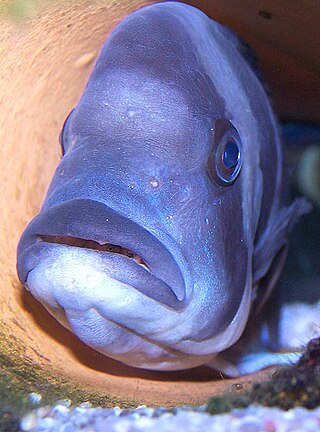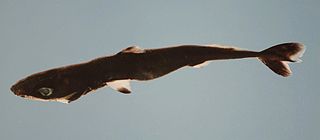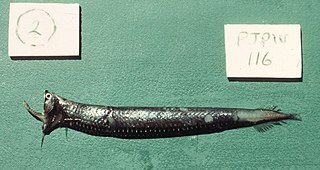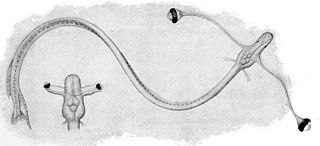Black dragonfish is a common name for several fish and may refer to the listed fish that appear underneath. These fish are the:
- Bathophilus indicus
- Idiacanthus atlanticus , a barbeled dragonfish of the family Stomiidae
- Idiacanthus fasciola
Black dragonfish is a common name for several fish and may refer to the listed fish that appear underneath. These fish are the:

Mouthbrooding, also known as oral incubation and buccal incubation, is the care given by some groups of animals to their offspring by holding them in the mouth of the parent for extended periods of time. Although mouthbrooding is performed by a variety of different animals, such as the Darwin's frog, fish are by far the most diverse mouthbrooders. Mouthbrooding has evolved independently in several different families of fish.

Stomiiformes is an order of deep-sea ray-finned fishes of very diverse morphology. It includes, for example, dragonfishes, lightfishes, loosejaws, marine hatchetfishes and viperfishes. The order contains 4 families with more than 50 genera and at least 410 species. As usual for deep-sea fishes, there are few common names for species of the order, but the Stomiiformes as a whole are often called dragonfishes and allies or simply stomiiforms.
Dragonfish may refer to:

Stomiidae is a family of deep-sea ray-finned fish, including the barbeled dragonfishes. They are quite small, usually around 15 cm, up to 26 cm. These fish are apex predators and have enormous jaws filled with fang-like teeth. They are also able to hinge the neurocranium and upper-jaw system, which leads to the opening of the jaw to more than 100 degrees. This ability allows them to consume extremely large prey, often 50% greater than their standard length.

Idiacanthus atlanticus, the black dragonfish, is a barbeled dragonfish of the family Stomiidae, found circumglobally in southern subtropical and temperate oceans between latitudes 25°S and 60°S, at depths down to 2,000 metres (6,600 ft). The species is sexually dimorphic: females are black with six stripes; males are brown, and lack the females' canine teeth, pelvic fins and barbel. They can weigh between 13-15 grams. Females are believed to make a diel vertical migration from deeper than 500 metres (1,600 ft) by day to surface waters at night, whereas males do not migrate, remaining below 1,000 metres (3,300 ft) at all times.

The spined pygmy shark is a species of squaliform shark in the family Dalatiidae found widely in all oceans. Growing no larger than roughly 28 cm (11 in), it is one of the smallest sharks alive, with this record beaten by the dwarf lanternshark. This shark has a slender, cigar-shaped body with a sizable conical snout, a long but low second dorsal fin, and an almost symmetrical caudal fin. Its sister species S. aliae and it are the only sharks with a spine on the first dorsal fin and not the second. Spined pygmy sharks are dark brown to black, with numerous bioluminescent organs called photophores on their ventral surface. The shark is believed to use these photophores to match ambient light conditions, which break up its silhouette and help the shark to avoid being seen by predators below.
Firefish may refer to the following groups or species of fish:
Eustomias schmidti, more commonly known as the scaleless dragonfish, is one of the many species included in the family of Stomiidae. Despite its small size, the scaleless dragonfish is a dangerous predator in the deep oceanic waters that uses its self-generated light to attract its prey.
Scaleless dragonfish may refer to:

Idiacanthus is a genus of barbeled dragonfishes, the larvae of which are noted for exhibiting the Stylophthalmine trait.
Melanostomias is a genus of barbeled dragonfishes.
Pachystomias microdon, the smalltooth dragonfish, is a species of barbeled dragonfish found in the oceans at depths of from 660 to 4,000 metres. This species grows to a length of 22.1 centimetres (8.7 in) SL. This species is the only known species in its genus.

Stomias is a genus of barbeled dragonfishes. They live in the mesopelagic zone of all oceans and show diel vertical migration and sexual dimorphism (males are smaller, have larger eyes and larger postorbital photophores than females.

The Dragonfish Nebula, as it is known for its appearance on infrared images, is a massive emission nebula and star-forming region 30,000 light-years from the Sun in the direction of the constellation Crux, the Southern Cross.

Stylophthalmus was a name used for what was previously believed to be a genus of fish with eyes perched upon periscopic stalks, known in some cases to be almost one third of the length of the animal's actual body. It is now recognised that all species in this genus are the fish larvae of already named, distantly related fish in the orders Stomiiformes and Myctophiformes which may have developed this same trait as a result of convergent evolution. Thus, Stylophthalmus is an invalid name.
Idiacanthus antrostomus, also known as the Pacific blackdragon or black sea dragon, is a species of barbeled dragonfishes noted for having ultrablack skin, similar to pigments like Vantablack.

Stomias boa, also known as the boa dragonfish, scaly dragonfish, dragon-boa or boa scaly dragonfish, is a species of deep-sea fish in the family Stomiidae. It is found at great depths worldwide in tropical to temperate oceans but is absent from the northern Pacific and northwest Atlantic Oceans.

Bathysphaera intacta, or the giant dragonfish, is a hypothetical species of fish described by William Beebe on 22 September 1932, having been spotted by the biologist as he descended to a depth of 640 metres off the coast of Bermuda.